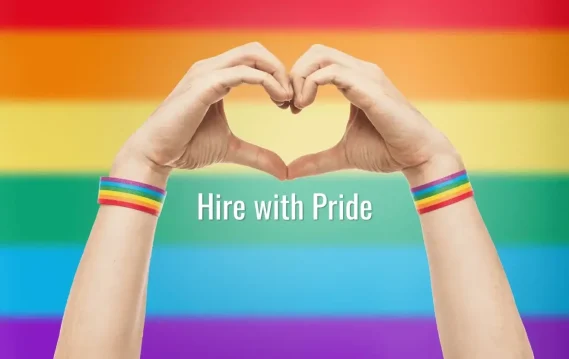This June, SPECTRAFORCE is focused on what it means to Hire with Pride. In this two-part blog series, we’re diving into a topic that’s close to our hearts and that should be a part of any company’s Pride strategy —inclusive LGBTQ+ hiring practices.
Part 1 explores why hiring with an LGBTQ+-focused mindset is essential, and provides some key tips on inclusive applications, job descriptions, and recruitment channels. Be sure to check it out before reading on!
In this post, we’ll take a closer look at LGBTQ+-friendly interview, hiring, and retention techniques. Without further ado, here are tips 5-8!
5. Train your teams in inclusive best practices, especially your hiring teams.
Ensure that your hiring team is well-educated and trained in inclusive hiring practices. Many workplaces still operate under heteronormative assumptions, where heterosexual relationships and cisgender identities are considered the norm. This can result in exclusionary practices, such as assuming candidates’ gender or marital status, or sidelining LGBTQ+-related topics or events.
Some easy changes include normalizing all diverse experiences and openly challenging assumptions about gender and marital status. Also, provide resources and workshops that address unconscious bias, LGBTQ+ terminology, and best practices for assessing candidates based on merit.
This will help create an inclusive interview environment where candidates feel comfortable and valued for who they are. And the investment in training will pay off – studies show that diverse workplaces perform significantly better than their less-diverse counterparts!
6. Enforce inclusive interview techniques that put training into action.
During interviews, use inclusive and respectful language. This only works successfully if it’s partnered alongside training for your recruitment team on unconscious bias, LGBTQ+ terminology, and best practices for assessing candidates solely on merit. Your goal is to create an environment where candidates can authentically present themselves without fear of judgment or discrimination. Avoid making assumptions about an applicant’s gender identity or sexual orientation – when pronouns are in doubt, just ask! Focus on the candidate’s qualifications, experiences, and potential for growth within the organization.
7. Make space for career-long inclusion and equity.
Consider establishing Employee Resource Groups (ERGs) or affinity groups within your organization that cater to the LGBTQ+ community. These groups can provide support, networking opportunities, and a safe space for employees to share their experiences. Highlighting these groups during the recruitment process showcases your commitment to inclusion and sends a positive message to potential candidates. And if you already have ERGs, be sure to make sure that’s known on your job posting sites and in your benefits lists.
8. Prioritize equal pay and benefits that support your LGBTQ+ employees.
Did you know that, on average, US LGBTQ+ workers earn 90 cents on the dollar to non-LBGTQ+ employees? Or that most health insurance providers don’t offer infertility coverage to same-sex couples or may categorize gender-affirming care as “cosmetic,” making it fully employee-paid?
Review your employee benefits and policies, including your equal pay policy, to ensure that they are supportive of the LGBTQ+ community. This can include offering domestic partner benefits and gender-neutral restrooms in the office. Companies with written non-discrimination policies and health insurance options that include benefits for gender-affirming care and infertility care are also highly sought after.
Additionally, one of the biggest post-COVID global employment trends is the search for workplaces that actively support employees’ mental health. LGBTQ+ individuals face higher rates of mental health challenges due to discrimination, stigma, and lack of support. The pressures of concealing one’s identity or navigating a non-inclusive environment can lead to increased stress, anxiety, and depression among LGBTQ+ employees. ERGs, mental health coverage, and DEI training for managers are all ways that you can create a supportive workplace.
Key Tip: All these inclusive policies and benefits should be highlighted throughout the year to your employees and clearly indicated in your recruitment materials. Soon, they’ll naturally show up in your online employee rating platforms.
In conclusion, if your internal hiring team and overall company culture do not actively support a diverse workforce, then great candidates and employees will be lost. Industry-leading organizations recognize the importance of authentically reflecting a range of backgrounds, experiences, and values – all of which are an investment in your company’s future. How so? Well, I’ll leave you with a few stats:
- 57% of consumers are more loyal to brands that commit to addressing social inequities
- 60% of employees under 40 expect their employer to have DEI program
- 84% of executives believe that lack of consistent DEI practices leads to high turnover rates
- Diverse companies with inclusive processes are:
- 21% more likely to experience above-average profitability
- 27% more likely to outperform their peers on longer-term value creation
- Two times faster making decisions, require half the meetings, and have 60% better results.
All this to say, during Pride month or otherwise, LGBTQ+-focused hiring practices are win-win for company growth and longevity.
Looking to join or partner with a company deeply committed to diversity, equity, and inclusion and finding NEWJOBPHORIA® for all? Check out SPECTRAFORCE’s DEI initiatives here.



